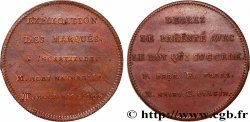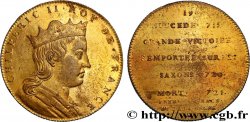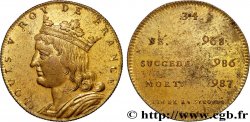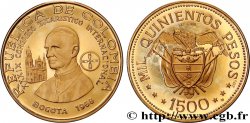E-auction 547-473513 - fme_861562 - METALLIC SERIES OF THE KINGS OF FRANCE Médaille, François Ier
You must signin and be an approved bidder to bid, LOGIN TO BID. Accounts are subject to approval and the approval process takes place within 48 hours. Do not wait until the day a sale closes to register. Clicking on « bid » constitutes acceptance of the terms of use of cgb.fr private e-auctions.
Bids must be placed in whole Euro amounts only. The sale will start closing at the time stated on the item description; any bids received at the site after the closing time will not be executed. Transmission times may vary and bids could be rejected if you wait until the last second. For further information ckeck the E-auctions F.A.Q.
NO BUYER'S FEE.
NO BUYER'S FEE.
| Estimate : | 15 € |
| Price : | 3 € |
| Maximum bid : | 4 € |
| End of the sale : | 09 October 2023 19:44:20 |
| bidders : | 2 bidders |
Type : Médaille, François Ier
Date: n.d.
Metal : copper nickel
Diameter : 33 mm
Orientation dies : 12 h.
Weight : 21 g.
Edge : Cannelée
Puncheon : corne d’abondance
Rarity : R2
Coments on the condition:
Quelques coups et rayures
Obverse
Obverse legend : FRANCOIS I ROY DE FRANCE..
Obverse description : Buste couronné à gauche.
Reverse
Reverse legend : 58. / NÉ 1494. / SUCCEDE 1515. / RETABLISSEMENT / DES SCIENCES ET DES / BEAUX ARTS. / MORT. 1547. / TROISIEME RACE. / P..
Reverse description : Légende en huit lignes.
Commentary
Refrappe ultra-moderne des séries de jetons.
François Ier (1494 – 1547), dit le Père et Restaurateur des Lettres, le Roi Chevalier, le Roi Guerrier, le Grand Colas, le Bonhomme Colas ou encore François au Grand Nez, est sacré roi de France le 25 janvier 1515 dans la cathédrale de Reims, et règne jusqu’à sa mort en 1547. Fils de Charles d’Angoulême et de Louise de Savoie, il appartient à la branche de Valois-Angoulême de la dynastie capétienne.
François Ier est considéré comme le monarque emblématique de la période de la Renaissance française[2]. Son règne permet un développement important des arts et des lettres en France. Sur le plan militaire et politique, le règne de François Ier est ponctué de guerres et d’importants faits diplomatiques.
Il a un puissant rival en la personne de Charles Quint et doit compter sur les intérêts diplomatiques du roi Henri VIII d’Angleterre toujours désireux de se positionner en allié de l’un ou l’autre camp. François Ier enregistre succès et défaites mais interdit à son ennemi impérial de concrétiser ses rêves, dont la réalisation toucherait l’intégrité du royaume. L'antagonisme des deux souverains catholiques a de lourdes conséquences pour l’Occident chrétien: il facilite la diffusion de la Réforme naissante et surtout permet à l'Empire ottoman de s'installer aux portes de Vienne en s'emparant de la quasi-totalité du royaume de Hongrie.
Pour la suite de sa biographie, voir http://fr.wikipedia.org/wiki/Fran%C3%A7ois_Ier_de_France.
Ultra-modern re-minting of token series.
Francis I (1494 – 1547), known as the Father and Restorer of Letters, the Knight King, the Warrior King, the Great Colas, the Good Man Colas or Francis with the Big Nose, was crowned King of France on January 25, 1515 in the cathedral of Reims, and reigned until his death in 1547.. Son of Charles of Angoulême and Louise of Savoy, he belongs to the Valois-Angoulême branch of the Capetian dynasty.
Francis I is considered the emblematic monarch of the French Renaissance period[2]. His reign allowed for significant development of the arts and literature in France. On the military and political level, the reign of François I was punctuated by wars and important diplomatic events..
He has a powerful rival in the person of Charles V and must count on the diplomatic interests of King Henry VIII of England, always eager to position himself as an ally of one camp or the other.. Francis I recorded successes and defeats but forbade his imperial enemy from realizing his dreams, the realization of which would affect the integrity of the kingdom.. The antagonism between the two Catholic sovereigns had serious consequences for the Christian West: it facilitated the spread of the nascent Reformation and, above all, allowed the Ottoman Empire to establish itself at the gates of Vienna, seizing almost the entire Kingdom of Hungary..
For the rest of his biography, see http://fr. Wikipedia. org/wiki/Fran%C3%A7ois_Ier_de_France
François Ier (1494 – 1547), dit le Père et Restaurateur des Lettres, le Roi Chevalier, le Roi Guerrier, le Grand Colas, le Bonhomme Colas ou encore François au Grand Nez, est sacré roi de France le 25 janvier 1515 dans la cathédrale de Reims, et règne jusqu’à sa mort en 1547. Fils de Charles d’Angoulême et de Louise de Savoie, il appartient à la branche de Valois-Angoulême de la dynastie capétienne.
François Ier est considéré comme le monarque emblématique de la période de la Renaissance française[2]. Son règne permet un développement important des arts et des lettres en France. Sur le plan militaire et politique, le règne de François Ier est ponctué de guerres et d’importants faits diplomatiques.
Il a un puissant rival en la personne de Charles Quint et doit compter sur les intérêts diplomatiques du roi Henri VIII d’Angleterre toujours désireux de se positionner en allié de l’un ou l’autre camp. François Ier enregistre succès et défaites mais interdit à son ennemi impérial de concrétiser ses rêves, dont la réalisation toucherait l’intégrité du royaume. L'antagonisme des deux souverains catholiques a de lourdes conséquences pour l’Occident chrétien: il facilite la diffusion de la Réforme naissante et surtout permet à l'Empire ottoman de s'installer aux portes de Vienne en s'emparant de la quasi-totalité du royaume de Hongrie.
Pour la suite de sa biographie, voir http://fr.wikipedia.org/wiki/Fran%C3%A7ois_Ier_de_France.
Ultra-modern re-minting of token series.
Francis I (1494 – 1547), known as the Father and Restorer of Letters, the Knight King, the Warrior King, the Great Colas, the Good Man Colas or Francis with the Big Nose, was crowned King of France on January 25, 1515 in the cathedral of Reims, and reigned until his death in 1547.. Son of Charles of Angoulême and Louise of Savoy, he belongs to the Valois-Angoulême branch of the Capetian dynasty.
Francis I is considered the emblematic monarch of the French Renaissance period[2]. His reign allowed for significant development of the arts and literature in France. On the military and political level, the reign of François I was punctuated by wars and important diplomatic events..
He has a powerful rival in the person of Charles V and must count on the diplomatic interests of King Henry VIII of England, always eager to position himself as an ally of one camp or the other.. Francis I recorded successes and defeats but forbade his imperial enemy from realizing his dreams, the realization of which would affect the integrity of the kingdom.. The antagonism between the two Catholic sovereigns had serious consequences for the Christian West: it facilitated the spread of the nascent Reformation and, above all, allowed the Ottoman Empire to establish itself at the gates of Vienna, seizing almost the entire Kingdom of Hungary..
For the rest of his biography, see http://fr. Wikipedia. org/wiki/Fran%C3%A7ois_Ier_de_France








 Report a mistake
Report a mistake Print the page
Print the page Share my selection
Share my selection Ask a question
Ask a question Consign / sell
Consign / sell
 Full data
Full data














